
Centre For Local Research into Public Space (CELOS)
Detroit
posted November 1, 2014
Three and a half hours west of Dufferin Grove Park in Toronto, at the southwest terminus of Highway 401, there is Detroit – a kind of living museum, a post-industrial city where over 10,000 households have had their water cut off, and people gather with buckets at fire hydrants to bring home water for cooking, washing, and flushing their toilets. In some city blocks of 10 houses, 8 might be abandoned, with four of those being just burned-out shells. Buying land is a bargain, especially for large buyers: in October 2014 a bundle of 6,350 mostly run-down and vacant tax-foreclosed Detroit properties was auctioned off to a developer for barely over $3 million. [Update: the developer changed his mind on Nov.5, and withdrew his offer.]
Detroit seems to be Exhibit A for the coming North American version of a European/South American-style “deep-austerity plan.” Shea Howell (of the James and Grace Lee Boggs Centre) in Detroit writes “Key to those legal frameworks is the elimination of public, democratic decision making.”
November 2010
Back in 2010, eight people who either worked at Dufferin Grove Park or were doing research with CELOS, or both, drove down to Indiana in two cars to visit with Elinor Ostrom, Nobel Prize winner for her work on the commons. The route passes through Detroit, and on the way back, we stopped there for a night. The people in the streets and in the bars and at community gardens, and in the soup kitchen where we ate lunch, were friendly and keen to talk – in fact we were bowled over by their hospitality, and we made some friends. read more
October 2014
Much has changed since then, and we've been back twice to learn from Detroiters -- more impressed each time. The most recent time, three of us went to Detroit for an ordinary-people conference called “Reimagining Work” – rich in content and in democratic deliberations. Some quotes and some commentary on the conference are here.
posted November 11, 2015
November 2015
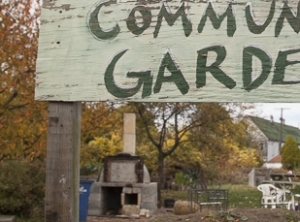
Photo by Marvin Shaouni
Following up: The online news "Model D" printed an article called "In search of Detroit's most beautiful blocks", with photos. One of the photos showed a garden with a wood oven in the background. This interested us particularly because of our public bake ovens website. But when we looked for more about the oven, we couldn't find any. But we found this excellent piece on the good results of "slow and steady." An excerpt from the introduction:
Hang a right at the community farm on the corner of Farnsworth Street and you'll be transported to an image from Detroit's past: a street with almost all of its houses intact, with mowed lawns, colorful homes, children playing on the sidewalks, and some lively foot traffic. Unlike many of the better-kept blocks in Detroit, this isn't a rich neighborhood for well-to-do boomerangers or old-money monarchs; it's a working-class street of sturdy old houses. more
Detroit visits
2010 visit: November
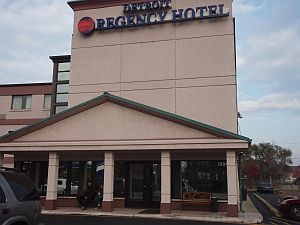
our hotel
We arrived in Detroit pretty late in the evening, 8 of us returning from our rather unsuccessful visit to last year's Nobel Prize winner Lin Ostrom (for her work on "governing the commons") in Bloomington, Indiana. She was very hospitable and so were her colleagues, but our group was not a good fit - we couldn't really explain ourselves, and they were pretty distracted about getting a big healthcare grant for their university.
The Detroit Regency is not the Beverly Hills Regency, but it's very cheap and in a great location very close to the waterfront but not in the built-up part of downtown. The office where we registered was protected by bullet-proof glass, as was the Macdonald's where we went to the bathroom the next day -- a first.
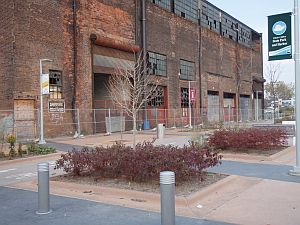
two worlds colliding, Defunct and Design
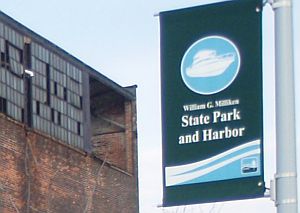
sign of reno world
Media
Housing and real estate
Paige Williams, Letter from Michigan: Drop dead, Detroit. The New Yorker, Jan.27 2014
"Oaklanders, in the friendliest possible way, kept giving me sombre warnings about Detroit, as if it were a netherworld filled with immediate, certain peril. Don’t go after dark, they advised; never stop directly behind another car; never ask for directions; never honk."
"...Oakland County has programs that court foreign biotech, biomedical, and alternative-energy companies, and that encourage life-science companies to collaborate with universities and hospitals. The county is getting into cloud computing. A thousand companies from forty countries, many from Germany and Japan, have set up operations in Oakland County; among them are Siemens, Volkswagen, Honda, and Toshiba. As Detroit tried to right itself by borrowing and spending—Q-tips applied to a cut jugular—Patterson’s administration froze government hiring, eliminated positions through attrition, and reconfigured pension and health-care plans."
Anna Clark, Detroit Magnate decides he doesn't want 6000 blighted properties after all. Nov.5 2014, Next City.
"The surprise cameo by an opportunistic developer skewed the city’s intentions for these properties and even worse, set up a scenario that would likely work against the city’s redevelopment strategy. In interviews, it was apparent that Strather had not a clue about what he would do with all this real estate or even what he legally could do."
"....nobody was expected to bid on this particular blight bundle. With no purchaser, the properties were expected to be transferred to the land bank, which would use the money from selling the good properties to pay for demolition on the bad properties."
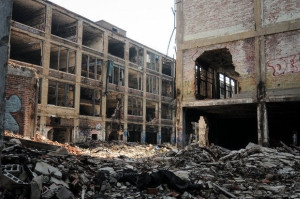
Packard Plant. Photo: Dave Muller
David Muller, Drones and senior housing? Detroit's Packard Plant owner tells east side community his plans for decrepit site. MLive.com, Nov.7 2014
The 3.5 million square ft. former Packard Plant (it closed in 1958 and was unused from 1990) was bought by a Spanish developed, Fernando Palazuelo, who says he lost all his money in the 2007/08 crash in Spain and then moved to Lima Peru to start over. He bought the plant for $405,000 plus unpaid taxes of $79,000, after two other offers fell through. On November 5 2014, there was a public meeting about his plans.
The plans for tenants seem to include seniors' housing and for business "the hope is to maybe attract dozens more non-manned aircraft companies, making it a drone hub."
(Really?)



 Show search options
Show search options






 You are on the [cover page] of folder [Detroit]
You are on the [cover page] of folder [Detroit]